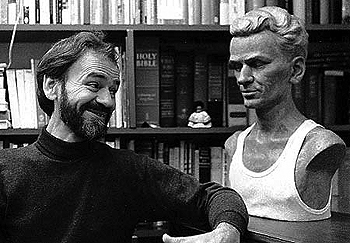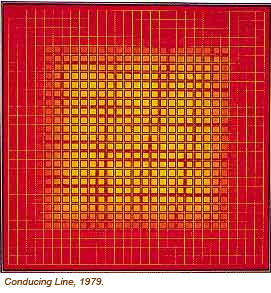Julian Stanczak, Painter
1969 CLEVELAND ARTS PRIZE FOR VISUAL ARTS
 The Cleveland Arts Prize committee’s recognition of
Julian Stanczak came at the peak of his fame as a major figure in the
Op Art movement. A master of the dynamic interplay of color and light,
Stanczak (born in 1928 in Borownica, Poland) had emerged in the late
1950s and early ’60s as a painter of extraordinary power and striking
originality. He was the first to use undulating lines in his paintings,
producing unsettling, quivering forms that seemed to shiver and throb
with light.
The Cleveland Arts Prize committee’s recognition of
Julian Stanczak came at the peak of his fame as a major figure in the
Op Art movement. A master of the dynamic interplay of color and light,
Stanczak (born in 1928 in Borownica, Poland) had emerged in the late
1950s and early ’60s as a painter of extraordinary power and striking
originality. He was the first to use undulating lines in his paintings,
producing unsettling, quivering forms that seemed to shiver and throb
with light.
And the art world was fascinated. In 1965 Stanczak’s work was included in more than a dozen solo and group shows around the U.S. One of his paintings was even reproduced in an advertisement for sunglasses in The New York Times: an indication of the degree to which he had seized the imagination of New York art circles. But the show that brought him to national attention was a huge exhibition mounted at the Museum of Modern Art that year called “The Responsive Eye”—a gathering of the work of 106 artists that announced the arrival of a new aesthetic.
 “Op”—or
optical—art played with the act of perception itself, more specifically
with the interaction of color and geometric form. (Stanczak himself
never liked the term, preferring to describe what he did, more
straightforwardly, as “perceptual art.”) Characterized by what art
historian Elizabeth McClelland called its “careful plotting and
surgical precision,” It offered a bracing alternative to the wild,
apparent formlessness of abstract expressionism.
“Op”—or
optical—art played with the act of perception itself, more specifically
with the interaction of color and geometric form. (Stanczak himself
never liked the term, preferring to describe what he did, more
straightforwardly, as “perceptual art.”) Characterized by what art
historian Elizabeth McClelland called its “careful plotting and
surgical precision,” It offered a bracing alternative to the wild,
apparent formlessness of abstract expressionism.
Having survived a harrowing childhood (a brutal Siberian labor camp
that cost the use of his right arm, escape to Teheran, living in a
straw hut in Uganda) Stanczak seemed to find solace and reassurance in
his repeating, subtly manipulated forms—as he did in the music of
Corelli, Boccherini and Vivaldi. It was the sights of Africa that set
him drawing feverishly—with his left hand—and led to art studies in
London, with its vibrant gallery scene. Settling in Cleveland with
relatives, young Julian enrolled at the Cleveland Institute of Art. He
would join its faculty in the mid-1960s and teach there until his
retirement in 1995.
It was his deepening fascination with the “behavior” of colors that drew him, after graduation, to Yale University to study (1954–56) with
Josef Albers, the great prophet of color theory and advocate of Bauhaus
precision. Stanczak has always insisted that his own art was very much
rooted in the natural world. As a young faculty member at the
University of Cincinnati (1957–1964), he looked out every
day from the window of his house on a hill overlooking the Ohio River,
mesmerized by the constant movement of the river and the changing
effects of light. It wasn’t the scene that interested him, he said, but finding a visual vocabulary that would allow him to or capture and “amplify” these phenonema.
 By
the mid-1960s his work was being shown in places like New York and Los
Angeles. But the artist himself preferred to remain in Cleveland, where
he could quietly pursue his own vision without distractions. There,
too, he had kindred spirits in the persons of fellow artists and CIA
faculty Richard Anuszkiewicz and Ed Mieczkowski, who shared his interest in visual perception.
By
the mid-1960s his work was being shown in places like New York and Los
Angeles. But the artist himself preferred to remain in Cleveland, where
he could quietly pursue his own vision without distractions. There,
too, he had kindred spirits in the persons of fellow artists and CIA
faculty Richard Anuszkiewicz and Ed Mieczkowski, who shared his interest in visual perception.
In the 1970s, Stanczak continued to
grow in stature and reputation. His paintings, prints and drawings were
shown at Washington, D.C.’s Corcoran Gallery and at the Martha Jackson
Gallery in New York, as well as in France, England and Germany. And his
work was acquired by major museums and collections here and abroad;
among them, the Corcoran, Hirshhorn and National galleries in
Washington, D.C, Boston’s Museum of Fine Arts, the San Francisco and
New York Museums of Modern Art, and the Cleveland and Metropolitan
museums—more than 60 public collections in all—as
well as those of prominent corporations (including Alcoa, Smith, Barney
& Company, Siemens, Sprint , Nissan and Chase Manhattan Bank) and
individuals (U.S. senators Jacob Javitz, Howard Metzenbaum and Nelson
Rockefeller).
Stanczak continued to explore new ideas and optical effects throughout the 1980s and ’90s, producing some of his most compelling canvases. In 1998 a retrospective exhibition covering 50 years of his work was jointly produced by the Butler Institute of American Art, the Columbus Museum of Art and the Josef Albers Museum in Germany.
—Dennis Dooley
